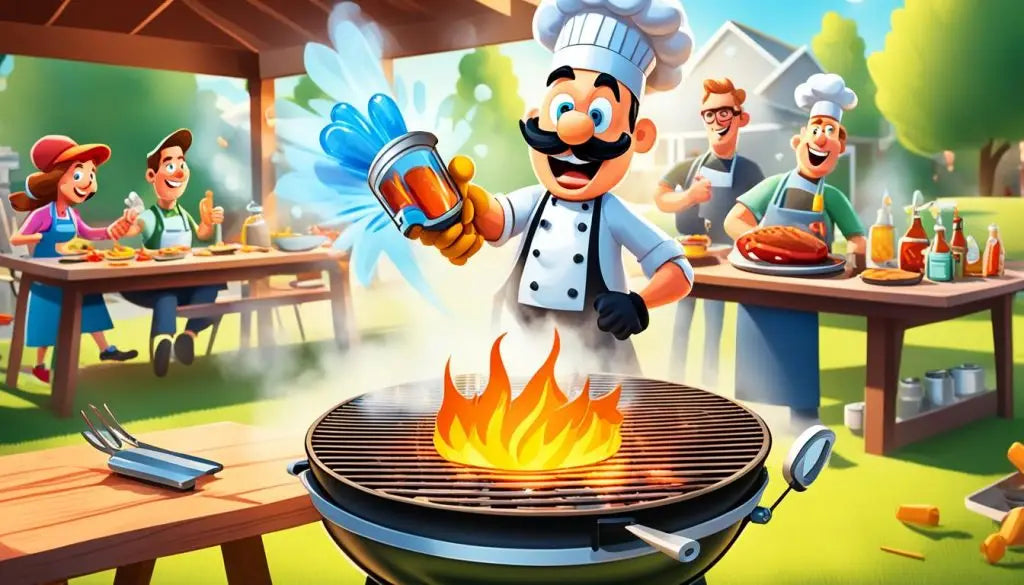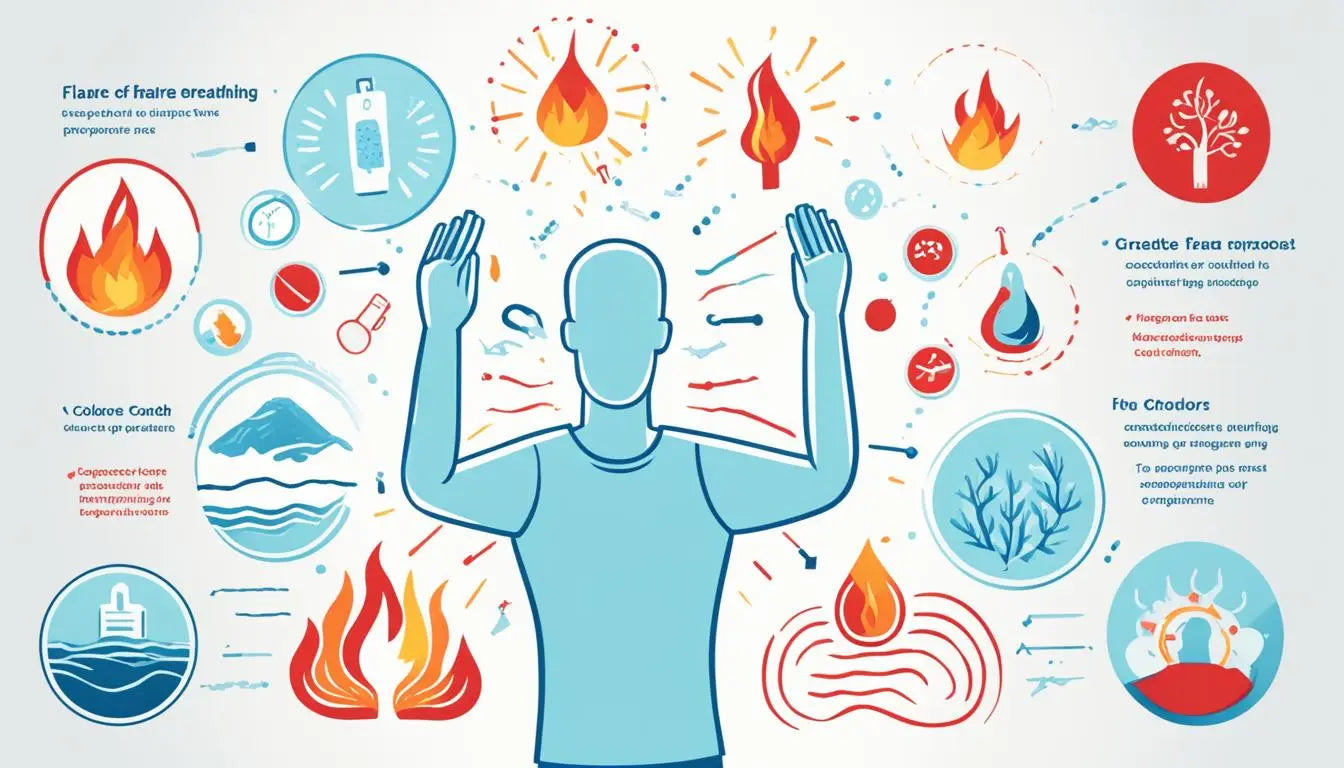Imagine taking care of a thriving garden. Suddenly, a weed appears, unexpected and unwanted. This is like managing flare-ups for those with chronic pain. Just as a gardener has tools to remove weeds, there are expert tips for flare-up management. These strategies help regain control and improve well-being. Flare-ups can be tough, but with the right approach, they can be managed smoothly. This guide is like having a shed full of tools to help you look after your health garden. It aims to make pain management better and boost your life quality.
Finding the best ways to manage flare-ups is often hard. It usually involves trying different methods, talking to doctors, and thinking about what works best for you. Whether flare-ups are new to you or not, the following expert advice will help. It offers insights into managing flare-ups and supports you on your path to a more comfortable life.
Key Takeaways
- Flare up management requires a personalised approach to suit individual needs.
- Expert tips can provide valuable guidance in managing flare ups effectively.
- Proactive strategies can help in anticipating and dealing with potential flare ups.
- Understanding the triggers of flare ups is essential for better pain control.
- Improving quality of life through effective flare up management is a realistic goal.
Understanding Flare Ups: Navigating Chronic Pain
Chronic pain often brings intense periods of discomfort known as flare ups. These can happen suddenly and affect both the body and mind. Understanding and managing these flare ups can lower their impact.
Defining Pain Flare Ups
Flare ups mean a sharp increase in chronic pain. This can disrupt daily life for hours or days. It's key to know about flare ups to help manage chronic pain.
Common Triggers of Pain Increases
Finding out what triggers pain flare ups is crucial. Triggers differ but often include physical strain or emotional stress. Here's a look at common triggers:
| Physical Triggers | Emotional/Stress Triggers |
|---|---|
| Overexertion | Anxiety |
| Poor Sleep | Depression |
| Weather Changes | Stressful Life Events |
| Injury | Relationship Conflicts |
Understanding these triggers can lead to better pain management.
The Psychological Impact of Flare Ups
The mental effects of flare ups are just as important as the physical ones. They can cause anxiety, hopelessness, and depression. Recognising this helps in treating chronic pain as a whole.
Identifying Your Personal Flare Up Triggers
Understanding your personal triggers is key when living with chronic pain. It helps manage the condition and improve your mood. This knowledge is crucial not just for health but also for activities like barbecuing, where flare ups can spoil the fun.
Consider the choice of barbecue spice rubs. Picking the right spices is vital to prevent dishes that could trigger flare ups, in cooking and health. Reflecting on triggers aids in living a life with fewer discomforts.
Understanding Your Chronic Pain Triggers
- Dietary Choices: The right barbecue spice, costing £6.95 to £60.95, can make a meal delightful. In contrast, inflammatory foods may increase chronic pain.
- Physical Activity: Doing too much can harm, similar to how choosing the wrong spice rubs can ruin a barbecue.
- Stress Levels: Stress quietly worsens chronic pain, like bad weather can ruin a BBQ.
https://www.youtube.com/watch?v=WP6BNQ7jEj4
By identifying flare up triggers, you learn to choose wisely, akin to picking the best barbecue ingredients. Everyone has different triggers, making it important to find out what specifically affects you. Realising each factor in chronic pain helps you manage it better, much like knowing which spice rubs to use enhances a BBQ.
Spotting personal triggers takes consistency and observation. Whether it’s managing chronic pain or perfecting your grilling, small discoveries can be made. These findings guide towards better choices, leading to an improved lifestyle.
So, I urge you to embark on this exploration. Understanding your unique patterns in chronic pain or barbecue can lead to a happier life without flare ups.
Effective Pain Management During Flare Ups
Flare ups can catch even the most experienced chronic pain sufferers by surprise. Having strategies for effective pain management and flare up management ready is crucial. These methods should be practical and straightforward for easing pain during flare-ups. Here, we share useful tips to lessen the pain during such difficult times.
Different people need different techniques for flare up management, because chronic pain varies from person to person. Some people benefit from medication alone, while others find relief through a combination of drugs and alternative therapies. We’ll discuss various approaches for tailored care below:
- Medication: Prescribed drugs like painkillers, anti-inflammatories, or muscle relaxants.
- Heat or Cold Therapy: Using warm packs or ice packs to lessen swelling and pain.
- Rest: Making rest and sleep a priority helps the body heal naturally.
- Meditation or Mindfulness: These practices help calm the mind, reducing stress that may make pain worse.
Choosing a method for chronic pain flare-ups matters, but integrating these strategies into your daily life is also key for effective pain management. Here's a comparison of common relief methods for pain relief during flare ups:
| Intervention | Benefits | Considerations |
|---|---|---|
| Prescription Painkillers | Fast relief, precise dosing | Possible side effects, risk of dependence |
| Over-the-Counter Medicines | Easy to get, many choices | May be weaker, can mix badly with other meds |
| Physical Therapy | Lasting approach, long-term gains | Takes dedication, might hurt at start |
| Alternative Therapies (e.g., acupuncture) | Non-invasive, focuses on whole body | Results vary, need to find skilled practitioner |
Using a combination of these methods can offer the best chance at effective pain management. Regular check-ups with medical professionals and keeping an eye on progress and adjustments will help you navigate through the ups and downs of chronic pain flare-ups smoothly.
Strategies to Mitigate Flare Up Onsets
Living with chronic pain demands a proactive stance. To prevent flare ups, adopting effective strategies to mitigate flare ups is key. A regular routine, driven by understanding personal triggers, helps build defence against unexpected pain episodes.
Activity and Warning Sign Diaries
Using activity diaries is a strong method for spotting patterns before a flare up occurs. By recording daily activities and how the body reacts, people can identify early warning signs. Adjustments to activities can then be made. This careful record-keeping, along with preventing flare ups, boosts self-awareness and control.
Sensible Planning and Pacing
In chronic pain management, planning and pacing activities matter a lot. Thoughtful planning spreads out tasks, ensuring breaks are taken and energy is well-used. This approach helps prevent overdoing it, which is vital to preventing flare ups.
| Feature | Benefits |
|---|---|
| Burns hotter than regular charcoal | Facilitates achieving the perfect sear on meat |
| Superior heat generation | Enables consistent cooking temperatures |
| Longer burn periods | Reduces the need for refueling, saving time and resources |
| Minimal smoke emission | Enhances the grilling experience |
| Natural and chemical-free | A healthier, eco-friendly grilling option |
| Distinctive smoky flavour | Improves taste of various foods |
| Versatile use technique | Suitable for searing and slow cooking methods |
By adopting these strategies to mitigate flare ups, people with chronic pain can lead active, fulfilling lives. They manage to ease the burdens of their condition this way.
Employing Non-Medicinal Therapies for Relief
Seeking alternatives to drugs for pain relief? Non-medicinal therapies can help. They not only ease symptoms but also give people more control over their pain. We'll explore how heat therapy, cold therapy, and TENS play a part in pain management.
How Heat and Cold Therapy Work
Heat therapy and cold therapy offer different benefits. Heat improves blood flow and eases tight muscles. Cold minimizes swelling and dulls severe pain.
Warm compresses or baths can apply heat, helping with muscle stiffness or arthritis. Cold treatments might use ice packs, great for new injuries or muscle pain after exercise.
The Role of TENS in Pain Management
TENS, or Transcutaneous Electrical Nerve Stimulation, uses electrical currents for pain relief. It targets nerves through the skin, possibly changing how we feel pain. TENS devices are handy, allowing people to address pain wherever they are.
Looking into non-medicinal pain relief means exploring various options like heat therapy. Let's compare this to grilling methods for a clear picture of how such treatments fit into everyday life.
| Grilling Method | Characteristics | Benefits |
|---|---|---|
| Charcoal | High heat, smoky flavour | Chemical-free, authentic experience |
| Gas | Precise temperature control | Quick start, consistent results |
| Electric | Easy to use, low maintenance | Even heating, portability |
Grilling styles, like heat therapy and TENS, offer unique benefits. For pain relief, finding the right approach is key. From easy use to effective treatment, each method serves a particular need.
In dealing with pain, results and convenience matter. Much like how cold therapy is straightforward and TENS uses new tech, choosing the right therapy is crucial for effective pain management. This variety means one can manage pain well without drugs.
The Importance of Cognitive Approaches During Pain Flare Ups
When dealing with pain flare ups, it's crucial to look at both the body and mind. Cognitive techniques offer ways to fight the emotional toll that pain often brings. By tackling negative thought patterns, people can find relief that isn't just physical.

Combating Negative Thought Patterns
Negative thoughts can make pain worse. Pain and bad feelings feed off each other, making a tough cycle to break. But, recognising these patterns is the first step to making a change. Once identified, you can break down these harmful thoughts. This helps ease discomfort and aids healing.
Cognitive Restructuring Techniques
Cognitive restructuring is key in changing our view and reaction to pain. It involves spotting and challenging unhelpful thoughts. This helps us see things more clearly and realistically. By doing this, one becomes more resilient to pain and better at coping with chronic pain challenges.
For instance, think of making restaurant grade lumpwood charcoal. It comes from woods like Chestnut, Ash, and Birch. Each piece is carefully made to burn hot and long with little ash. In a similar way, cognitive restructuring helps sort and improve our thoughts. This improves mental health during pain flare ups.
Managing Flare Ups: Physical Approaches
Managing flare ups requires attention to physical approaches. Keeping an eye on pain and posture during daily tasks helps lessen discomfort. It's also key to incorporate gentle exercise and stretches. These steps are vital for staying flexible and controlling symptoms.
Pain and Posture: Managing Daily Activities
Our usual way of standing or sitting can make pain worse. It's vital to learn how to improve our body's alignment. This helps us control flare-ups better. Making small changes in how we sit or stand during the day is crucial. It prevents extra strain and helps avoid making symptoms worse.
- Switching positions often during long tasks to prevent stiffness
- Using items like ergonomic chairs to support better posture
- Setting up workspaces to avoid too much bending or stretching
Adding these habits to your daily life protects you from the bad effects of poor posture on flare ups.
Gentle Exercise and Stretches to Ease Discomfort
Dealing with flare ups needs a careful approach to activity. Starting gentle exercises and stretches helps ease pain. These activities also boost our physical strength and ability to handle discomfort. Here are some steps to slowly add to your routine:
- Doing breathing exercises to relax and loosen tight muscles
- Enjoying low-impact activities, like walking or swimming, that don't push you too hard
- Doing specific stretches to improve flexibility and motion
These steps are essential for actively controlling pain flare ups. They help improve our overall well-being.
Knowing how our body handles pain helps us apply these physical approaches better. Though expert advice is important, managing on our own is also crucial in lessening the everyday effects of chronic conditions. Being aware, making small posture changes, and exercising gently are key to managing flare ups well.
For detailed insights into how different methods can impact heat during cooking, check out why lumpwood charcoal is preferred to briquettes. Learning about efficient, high-heat cooking offers a deeper understanding of managing physical flare ups.
Medication Management: Navigating Dosages and Prescriptions
If you're dealing with chronic pain, knowing how to properly use your medication is key. Good medication management can bring you much-needed pain relief. It also helps prevent pain from getting worse. It's vital to take the right dosages and follow your prescriptions closely to manage pain well.
Understanding Your Pain Relief Medications
Learning about pain medications means understanding how they work, possible side effects, and keeping to the correct dose. The doses must match your specific needs. Ignoring this can cause issues or reduce the medicine's effectiveness.

Coordinating Medication Intake with Your GP
Working with your GP is essential for managing pain effectively. This teamwork approach helps tailor your treatment. Your GP checks your medications regularly. They ensure everything works together towards your health goals.
There are many aids for managing pain these days. For additional options for comfort, you might look into specialised grilling and barbecue suppliers. They offer both physical and psychological relief.
| Type of Wood | Price | Stock Availability | Production Area |
|---|---|---|---|
| Oak, Hickory, Maple, Mesquite |
|
In stock: 3 | United States, South America, UK |
Creating a Personalised Action Plan for Flare Ups
Effective management of chronic pain needs you to be ahead of the game. Creating a personalised action plan that fits you perfectly is key to managing flare ups. Your plan should cover not just how to ease the pain but also lifestyle changes and coping methods.
A solid flare up management plan is a big part of handling chronic pain. It means being ready before pain starts, knowing what causes your pain, ways to prevent it, and what to do when it hits. The table below shows what goes into making a good plan:
| Component | Details | Example |
|---|---|---|
| Trigger Identification | Log activities, foods, or stressors that bring on a flare up | Eating processed foods, not getting enough sleep |
| Preventive Strategies | Do things to lower the chance of a flare up | Practice relaxation techniques every day |
| Immediate Response | What to do right away when a flare up happens | Take pain relief medicine as prescribed, use heat therapy |
| Review and Adapt | Check regularly how well the plan works and make updates | Look over the plan every two weeks, change it as needed |
Think of this like choosing the right type of charcoal for high heat cooking. If you need high heat, premium hardwood lump charcoal is better than briquettes. It's not just about the heat; choosing eco-friendly options shows you care about the environment. This level of detail is what you need in a chronic pain management plan too.
So, applying the same logic to choosing charcoal:
- Trigger Identification: Know that you need high heat for cooking.
- Preventive Strategies: Look for and buy charcoal that meets your heat needs.
- Immediate Response: Use the right amount of hardwood lump charcoal for more heat.
- Review and Adapt: Check how your food comes out and change the type or amount of charcoal next time.
Understanding a personalised action plan is good not just for managing flare ups but also for tackling daily life challenges smartly.
Managing Grilling Flare Ups
The smell of sizzling food shows grilling season has arrived. But, managing grilling flare ups can be tough. These flames are risky and can spoil your meal. Knowing why flare ups happen and using tips can make grilling safe and enjoyable.

Grilling tips begin with cleaning your grill. It's crucial to clean away fat and leftover food to avoid flare ups. Keep a water spray bottle or a fire extinguisher handy for any surprises. By controlling the heat and arranging food properly, you can keep fat from reaching the flames.
- Keep your grill clean to avoid fat and food residue build-up.
- Position a water spray bottle nearby to quell any sudden flare ups.
- Control the heat to manage how quickly foods cook and potentially drip fat.
- Use indirect cooking methods for fatty foods to reduce flare ups during cooking.
Let's look at a detailed table of what to do and not do to prevent flare ups:
| Grilling Practice | Do | Don't |
|---|---|---|
| Cleaning the Grill | Regularly clean grates and interior spaces to remove grease and residues. | Allow grease to accumulate, increasing the risk of high flare ups. |
| Managing Drippings | Use a drip pan to catch fat and reduce direct contact with flames. | Ignore fatty drips; they are a primary cause of flare ups during cooking. |
| Cooking Technique | Opt for indirect grilling methods for fatty cuts to minimise flare ups. | Place greasy foods directly over high flames, prompting unsafe flare ups. |
| Temperature Control | Maintain a moderate and even temperature suited to the food you're grilling. | Overheat the grill unnecessarily, which can lead to unmanageable flare ups. |
Following these steps helps in managing grilling flare ups well. It ensures safety for you and your guests. Remember, barbeque safety creates great outdoor meals without flare ups. A well-managed grill leads to delicious meals everyone remembers.
Conclusion
We have covered many ways to handle the tough challenge of managing flare ups from chronic pain. We talked about finding what triggers your pain and how to deal with it using different methods. This information aims to help you lessen the pain's impact and how often it happens. Managing pain well requires ongoing effort and listening to what your body tells you.
Using non-drug treatments, thinking strategies, and physical techniques are part of a whole-body approach. Knowing how to handle your medication and making a custom plan are key. They are not just quick fixes but the base for long-lasting relief and better control over your health. These expert tips and steps are vital for keeping on top of flare ups.
The journey to manage chronic pain well is very personal. It needs patience and the willingness to change. By adding these expert ideas into your life, a better quality of life is within reach. With commitment and taking action, you can deal with chronic pain better. You'll feel more in control and hopeful about the future.
FAQ
What are pain flare ups?
Pain flare ups are sudden increases in pain felt by people with long-lasting pain. The pain gets worse quickly and can be short-lived or last a long time.
What are the common triggers that can cause pain increases?
Common triggers for pain increases include doing too much physically, cold weather, stress, not enough sleep, and certain activities that stress the sore area.
How do flare ups affect individuals psychologically?
Flare ups can make people feel upset, frustrated, anxious, and even depressed. It's vital to manage these feelings to control the pain better.
How can I identify my personal flare up triggers?
To find your flare up triggers, note down activities, weather, feelings, and other factors when your pain gets worse. This helps in spotting patterns and understanding your triggers.
What can I do to relieve pain during flare ups?
To ease pain during flare ups, you can take medicine, try heat or cold treatment, explore alternative therapies, practice self-care, and get help from medical pros.
How can I prevent the onset of flare ups?
Preventing flare ups means living a balanced life, tracking your activities and symptoms, planning wisely, and avoiding known triggers. These steps can lessen flare ups in frequency and harshness.
How do heat and cold therapy help with pain relief during flare ups?
Heat therapy, like warm baths or heating pads, can make blood flow better and relax muscles to help with pain temporarily. Cold therapy, with ice packs or cold wraps, can lessen inflammation and numb the affected spot, easing pain and swelling.
What is the role of Transcutaneous Electrical Nerve Stimulation (TENS) in managing pain flare ups?
TENS involves using low electrical currents on the body to block pain messages and increase good feelings in the body, helping with flare up pain relief.
How can cognitive approaches help with coping during pain flare ups?
Cognitive methods mean understanding and changing negative thoughts, seeing pain differently, and using coping strategies. These can help change how you deal with the mental side of flare ups.
What physical approaches can be beneficial during flare ups?
Keeping good posture and pain control in daily life can lower discomfort. Light exercise and stretching, suited to your needs, can boost flexibility and reduce pain in flare ups.
How should I manage my pain relief medications during flare ups?
Knowing your pain relief meds well, including how much to take and side effects, is key. Work with your GP to make sure your medication plan is right for your pain management and safe.
How do I create a personalized action plan for managing flare ups?
Make your own plan by picking out strategies and techniques that help you handle flare ups. This plan might include dealing with triggers, using pain management methods, focusing on self-care, and getting support from medical experts.
How can I effectively manage grilling flare ups?
To control grilling flare ups, manage the heat well, grill with indirect heat, minimize fat drips, and keep a fire extinguisher nearby. By using these expert tips, you can grill safely and enjoyably.

